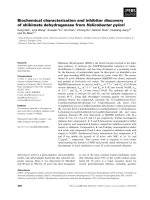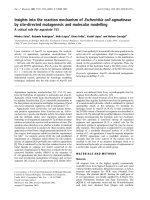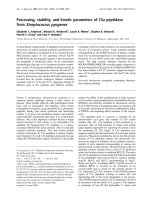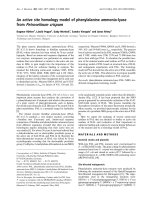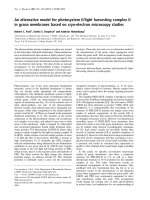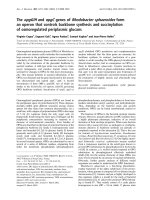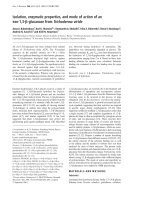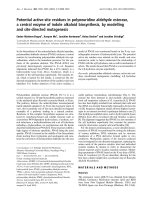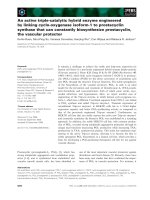Báo cáo Y học: An active site homology model of phenylalanine ammonia-lyase from Petroselinum crispum docx
Bạn đang xem bản rút gọn của tài liệu. Xem và tải ngay bản đầy đủ của tài liệu tại đây (741.26 KB, 11 trang )
An active site homology model of phenylalanine ammonia-lyase
from
Petroselinum crispum
Dagmar Ro¨ ther
1
,La
´
szlo
´
Poppe
2
, Gaby Morlock
1
, Sandra Viergutz
1
and Ja
´
nos Re
´
tey
1
1
Institute for Organic Chemistry, University of Karlsruhe, Germany;
2
Institute for Organic Chemistry, Budapest University of
Technology and Economics, Hungary
The plant enzyme phenylalanine ammonia-lyase (PAL,
EC 4.3.1.5) shows homology to histidine ammonia-lyase
(HAL) whose structure has been solved by X-ray crystal-
lography. Based on amino-acid sequence alignment of the
two enzymes, mutagenesis was performed on amino-acid
residues that were identical or similar to the active site resi-
dues in HAL to gain insight into the importance of this
residues in PAL for substrate binding or catalysis. We
mutated the following amino-acid residues: S203, R354,
Y110, Y351, N260, Q348, F400, Q488 and L138. Deter-
mination of the kinetic constants of the overexpressed and
purified enzymes revealed that mutagenesis led in each case
to diminished activity. Mutants S203A, R354A and Y351F
showed a decrease in k
cat
by factors of 435, 130 and 235,
respectively. Mutants F400A, Q488A and L138H showed a
345-, 615- and 14-fold lower k
cat
, respectively. The greatest
loss of activity occurred in the PAL mutants N260A, Q348A
and Y110F, which were 2700, 2370 and 75 000 times less
active than wild-type PAL. To elucidate the possible func-
tion of the mutated amino-acid residues in PAL we built a
homology model of PAL based on structural data of HAL
and mutagenesis experiments with PAL. The homology
model of PAL showed that the active site of PAL resembles
the active site of HAL. This allowed us to propose possible
roles for the corresponding residues in PAL catalysis.
Keywords: phenylalanine ammonia-lyase; PAL; MIO; site-
directed mutagenesis; homology model.
Phenylalanine ammonia-lyase (PAL; EC 4.3.1.5) is a very
important plant enzyme that catalyses the conversion of
L
-phenylalanine into E-cinnamic acid which is the precursor
of a great variety of phenylpropanoids, such as lignins,
flavonoids and coumarins [1,2]. Because of its central role in
plant metabolism, PAL is a potential target for herbicides
[2].
The related enzyme histidine ammonia-lyase (HAL;
EC 4.3.1.3) catalyses a very similar reaction, converting
L
-histidine into E-urocanic acid. Amino-acid sequence
comparison of histidine and phenylalanine ammonia-lyases
from different organisms revealed that there are several
homologous regions indicating that their active sites are
very similar [3]. For about 30 years it has been believed that
a dehydroalanine acts as electrophilic prosthetic group at
theactivesiteofbothHALandPAL[4–6].Recentlythe
three-dimensional structure of HAL was solved by X-ray
crystallography revealing that the electrophilic prosthetic
group 3,5-dihydro-5-methylidene-4H-imidazol-4-one (MIO)
is the catalytically essential moiety rather than the dehydro-
alanine (Fig. 1) [7]. It has been proposed that this MIO
group is generated by autocatalytic cyclization of the A142-
S143-G144 moiety of HAL. This process resembles the
fluorophore formation of the green fluorescent protein [8].
More recently, we provided spectroscopic evidence for the
presence of a prosthetic MIO group at the active site of PAL
[9].
Here we report the exchange of several amino-acid
residues in PAL that are identical or similar to active site
residues of HAL and evaluation of their importance in
substrate binding and catalysis by enzyme kinetic behaviour
of the mutants and by a homology model of PAL.
MATERIALS AND METHODS
Bacterial strains and plasmids
Wild-type PAL and PAL mutants were overexpressed in
E. coli BL21(DE3) cells. The gene coding for phenylalanine
ammonia-lyase from P. crispum was changed to the codon-
usage of E. coli and cloned in vector pT7-7 followed by a
transformation in E. coli BL21(DE3) cells containing vector
pREP4-GroESL [10].
Site-directed mutagenesis
Phenylalanine ammonia-lyase mutants were produced by
following the instruction manual of the QuickChange(tm)
Site-Directed mutagenesis kit (Stratagene) [11]. The oligo-
nucleotides used in the mutagenesis reactions were:
S203A(+): 5¢-catcactgctgccggcgacctgg-3¢, S203A(–): 5¢-cca
ggtcgccggcagcagtgatg-3¢; Q488A(+): 5¢-cagcacaacg ctgacgt
taac-3¢, Q488A(–): 5¢-gttaacgtcagcgttgtgctg-3¢; Q488E(+):
Correspondence to J. Re
´
tey, Institute of Organic Chemistry,
University of Karlsruhe, Richard-Willsta
¨
tter-Allee,
D-76128 Karlsruhe, Germany.
Fax: + 49 721 6084823, Tel.: + 49 721 6083222,
E-mail:
Abbreviations: PAL, phenylalanine ammonia-lyase; HAL, histidine
ammonia-lyase; MIO, 3,5-dihydro-5-methylidene-4H-imidazol-4-one.
Enzymes: histidine ammonia-lyase (EC 4.3.1.3); phenylalanine
ammonia-lyase (EC 4.3.1.5).
Note: in this paper, the numbering of amino acids for PAL from
P. crispum is consistent with the SWISS-PROT database (P24481)
record but not with the numbering used in previous PAL papers.
(Received 15 February 2002, accepted 8 May 2002)
Eur. J. Biochem. 269, 3065–3075 (2002) Ó FEBS 2002 doi:10.1046/j.1432-1033.2002.02984.x
5¢-cagcacaacgaagacgttaac-3¢, Q488E(–): 5¢-gttaacgtctcgttg
tgctg-3¢; Y351F(+): 5¢-caggaccgttttgctctgcg-3¢, Y351F(–):
5¢-cgcagagcaaaacggtcctg-3¢; Y110F(+): 5¢-ccgactcctttggcg
ttacc-3¢, Y110F(–): 5¢-ggtaacgccaaaggagtcgg-3¢; R354A(+):
5¢-cgttatgctctggctacctctcc-3¢, R354A(–): 5¢-ggag aggtagccag
agcataacg-3¢; N260A(+): 5¢-gcactggttgctggtaccgctg-3¢,
N260A(–): 5¢-cagcggtaccagcaaccagtgc-3¢;Q348A(+):5¢-aa
acgaaagcggaccgttat-3¢, Q348A(–): 5¢-ataacggtccgctttcgg
ttt-3¢; F400A(+): 5¢-ggtggtaacgcccaggggac-3¢, F400A(–):
5¢-gtc ccctgggcgttaccacc-3¢; L138H(+): 5¢-gatccgcttccacaacg
ctg-3¢, L138H(–): 5¢-cagcgttgtggaagcggatc-3.
The mutations were verified by sequence analysis using
the dideoxynucleotide chain-termination method [12].
Protein expression and purification
E. coli BL21 (DE3) cells carrying the plasmids with the
genes for wild-type PAL and PAL mutants were cultured
and PAL was purified as described previously [10].
SDS/PAGE and Western blot analysis
SDS/PAGE was carried out according to Laemmli [13]
using 10% polyacrylamide gels. The gels were stained with
Coomassie Brillant Blue R250. Western Blot analyses were
performed following a previously described method using
nitrocellulose blotting filters [14,15]. Wild-type PAL and
mutants were detected with rabbit polyclonal antibodies
raised against PAL from P. crispum (the antibody was a
generous gift of N. Amrhein, Eidgeno
¨
ssische Technische
Hochschule, Zu
¨
rich).
Enzyme assay and determination of protein
concentration
PAL activity was measured spectrophotometrically at 30 °C
following the formation of E-cinnamate at 290 nm. The
assay was performed in 1-cm quartz cuvettes by modifica-
tion of the method described in [16] with enzyme concen-
trations varying between 10 and 20 lg for active enzymes
and between 0.3 and 0.4 mg for less active mutants. The
enzyme was preincubated at 30 °C for 5 min in 750 lLof
0.1
M
Tris/HCl pH 8.8. The reaction was started by adding
250 lLofa20-m
ML
-phenylalanine solution. Wild-type
enzyme and moderately active mutants were measured in
intervals of 1 min for 5 min, less active enzyme mutants
were measured in intervals of 5 min for 20 min. For
determination of K
m
and V
max
,
L
-phenylalanine concentra-
tions were varied from 0.01 to 5 m
M
. Kinetic constants (K
m
,
V
max
) were determined using a double reciprocal plot [17].
The isolated enzymes were electrophoretically pure as
verified by staining with Coomassie Brillant Blue R250
and therefore it was possible to measure the turnover
numbers (k
cat
) with the relative molecular mass of 311.313
for the tetrameric PAL. Determination of protein concen-
tration was carried out according to Warburg & Christian
[18,19], Murphy & Kies [20] and Groves et al. [21]. BSA was
used as reference protein for the measurements.
Sequence comparison
Amino-acid sequences of HAL from P. putida [22], HAL
from Homo sapiens [23] and PAL from P. crispum [24] were
extracted from the SWISS-PROT database. Sequence
alignment was carried out using the computer program
MALIGN
(HUSAR, DKFZ Heidelberg).
MALIGN
is a
HUSAR adaptation of the program
MAP
[25].
Homology modelling
Model of PAL 64–531 monomer. The sequence of PAL
(Swiss-Prot: P24481) was submitted to SWISS-MODEL
(Automated Protein Modelling Server) [26,27]. The PAL
structure homology model resulting from this first
approach, which was folded over the HAL structure
(PDB: 1B8F), contained amino acids 64–531 [28]. This
partial model was optimized by different molecular me-
chanics force fields using
CHARMM
[29], Amber-95 [30,31]
and MM3Prot [32] force field implementations in the
TINKER
[33] package; Amber3 and MM+ force field
implementations in
HYPERCHEM
[34] package; and the
GROMOS 96 43B1 [35] implementation in
SWISS
-
PDBVIEW-
ER
. Calculations were performed on 300–850 MHz Pen-
tium III computers running under
WINDOWS
95,
WIN-
DOWS
98 or
LINUX
(
REDHAT
6.2). A switched smoothing
function, which gradually reduced nonbonding interactions
to zero from a 10-A
˚
inner radius to a 14-A
˚
outer radius, was
generally applied. Otherwise, all the calculations here and
later were performed by using default settings of the
program packages. These optimized structures were
compared by
GROMOS
single point energy calculations and
Fig. 1. The MIO moiety in HAL from P. putida. The mechanism of
the PAL reaction through Friedel–Crafts type attack of MIO on the
phenyl ring of
L
-phenylalanine.
3066 D. Ro
¨
ther et al. (Eur. J. Biochem. 269) Ó FEBS 2002
Ramachandran plot analyses using the
SWISS
-
PDBVIEWER
3.6 package [27]. For further modelling, the PAL 64–531
monomer optimized by MM+ force-field of
HYPERCHEM
[34] was used. During the MM+ optimization, the A202-
S203-G204 triad was replaced by MIO in this structure.
Model of PAL 64–531 homotetramer. The raw PAL
64–531 fragment homotetramer was built by the
SWISS
-
PDBVIEWER
3.6 [27] package using the MM+ optimized
PAL 64–531 fragment model and the cell parameters of the
HAL structure (space group: I222) [7]. The MIO structures
were rebuilt by MM+ calculation and kept frozen in the
homotetramer during Amber3 optimization performed by
HYPERCHEM
[34].
Model of PAL 1–63 fragment: The 1–63 fragment of PAL
was built using secondary structure prediction data
(obtained by using PHDsec, version 5.94–317 [36,37], and
3D-PSS Psi-Pred [38,39]). Raw three-dimensional models
corresponding to the predicted secondary structure were
built and optimized in the
HYPERCHEM
[34] and
SWISS
-
PDBVIEWER
3.6 [27] packages. Evaluation of the raw three-
dimensional models as described for the PAL 64–531
fragment resulted in the best fold of the 1–63 fragment.
Model of PAL 532–716 fragment. Swiss-MODEL [26,27]
has not found a template eligible for modelling the
terminal fragment (532–716) of the PAL sequence (Swiss-
Prot: P24481). Although several reasonable hits were
found when the 532–716 fragment was submitted to
3D-PSS search [38,39] (e.g. 15% identity over 184 amino
acids with 1FPW chain A; 19% identity over 184 amino
acids with 1JBA chain A; 22% identity over 172
amino acids with 2FHA; 18% identity over 153 amino
acids with 1BG7; 17% identity over 179 amino acids
with 1AKE chain A; 22% identity over 162 amino acids
for 1GGQ chain A), the first approach models built
from these templates by
SWISS
-
PDBVIEWER
7.02 [27]
showed no proper contacts with the core 64–531
fragment. The secondary structure prediction data for
the whole PAL sequence (by using
PHDSEC
[36,37])
showed 14% identity over 184 residues between the PAL
532–716 sequence fragment and the 91–275 fragment of
chain B in the aspartase structure (PDB accession no.
1JSW) [40,41]. Because aspartase is also an ammonia-
lyase and its structure shows substantial structural
similarity to that of the template HAL (long parallel
helices and a quasi tetrameric structure), the PAL
532–716 fragment was modelled using chain B of the
aspartase structure as template by the
SWISS
-
PDBVIEWER
7.02 [37] package providing the 532–716 model fitting
best to the core 64–531 fragment.
Model of the full PAL 1–716 monomer. The full PAL
1–716 monomer was obtained from the optimized PAL
1–63, 64–531 and 532–716 fragments by manual adjust-
ments and rigid-body approach optimizations using by the
TINKER
package [33]. The rms fit of four full PAL 1–716
monomers over the Amber3-optimized PAL 64–531 frag-
ment homotetramer indicated the necessity of modifications
in the 621–640 loop of the full PAL model avoiding spatial
overlap. The necessary loop modifications in the full PAL
monomer were made by the
SWISS
-
PDBVIEWER
3.6 [27]
package, followed by Amber3 optimization of the outside
area (fragments 1–70 and 525–716 in each monomer chain)
of the reconstituted full PAL homotetramer by the
HYPER-
CHEM
[34] program.
Quality assessment of the model
Analysis of the full PAL homotetramer was performed by
the
SWISS
-
PDBVIEWER
7.02 [27] package. No significant
clashes were found in the contact regions between the
unique chains. The aspherical nature of the active homo-
tetramer form of PAL is supported by the sedimentation
constant and the Stokes’ radius data found by sucrose
density gradient centrifugation of PAL from potato [42].
Of the 716 amino acids in the chain A of the model, 43
were outside of the likely Phi/Psi combinations in the
Ramachandran plot (including Gly and Pro). Most of the
deviations were found in the 64–531 and the 532–716
fragments (29 and 14, respectively), whereas only one
difference was found in the 1–63 fragment. Further
quality assessments were made by
WHAT IF
v4.99 [43,44]
[e.g. bond lengths Z score 0.528 ± 0.012; 27 bumps
between atomic pairs over 0.1 A
˚
; four Gly residues have
unusual backbone oxygen position; the rms Z score for all
improper dihedrals (1.253) was within normal ranges;
packing Z scores less than )2.50 were found for I141:
)3.68, H309: )2.93, R52: )2.80, F
621
: )2.73, E291: )2.51,
P699: )2.50] and
PROCHECK
V3.5 [45,46] through EMBL
the Biotech Validation Suite, Heidelberg [47]. Although
some deviations in bond lengths, angles, side chain
planarities and hydrogen bonding environments were
found by these checks, mainly in the terminal 532–716
fragment, the
PROCHECK
overall average G factor for the
protein ()0.35) was acceptable. Because the model gave
reliable assembly around the active site, for which a good
match of residues from three chains is necessary, it seems
to be trustworthy, at least in this region.
Optimization and substrate fit within
the active site area
Analysis of the full PAL homotetramer showed that S203 is
fully covered by residues of three monomer subunits within
a global area of 25 A
˚
radii. This part was cut from the full
PAL homotetramer model, and used for modelling the
substrate-free and substrate binding states of the active site
by MM+ calculations [34] within 15-A
˚
radii around S203.
The outside sphere between 15 and 25 A
˚
of the whole 25-A
˚
radii globe was kept ÔfrozenÕ during the calculations, which
were performed on 1949 atoms within the 15-A
˚
inside area.
Conformational analysis of phenylalanine in its zwitter-
ionic state by PM3 calculations of
PC SPARTAN PRO
[48]
package was performed [28], and the lowest energy confor-
mation was used as starting structure of the substrate. The
zwitterionic
L
-Phe structure was docked to the substrate-
free active site model by applying the following consider-
ations: (a) the C
2
position of the phenyl ring of
L
-Phe should
be close enough to the methylene of the MIO to perform the
nucleophilic addition to the C ¼ C double bond; and (b) the
NH
3
+
and the pro-S b-H should be antiperiplanar [28].
Several, slightly different arrangements satisfied these
requirements. These starting structures containing the
zwitterionic
L
-
PHE
substrate were optimized by MM+
Ó FEBS 2002 Active-site model of phenylalanine ammonia-lyase (Eur. J. Biochem. 269) 3067
method of the
HYPERCHEM
[34] program, and the one of the
lowest energy was considered as the best fit (Fig. 5A).
The r-complex-like intermediate state was obtained by
constructing a single bond between the
L
-Phe C
2
and MIO
methylidene C atoms, correcting the atom and bond types
and orders, and relaxing the structure by MM+ optimiza-
tion (Fig. 5B). The E-cinnamate/ammonia binding model
was obtained from the r-complex model by breaking the
appropriate bonds, correcting the atom and bond types and
orders, and optimizing the structure by MM+ method
(Fig. 5C).
Overlay of the models on the HAL structure
The substrate-free active site model (25 A
˚
radius around
the MIO) for PAL was overlaid onto the similar portion
of the experimental structure of HAL containing a
sulfate ion [7] by the
SWISS
-
PDBVIEWER
3.7 [27] package
(Fig. 4A). The models were visualized using the
WEBLABVIEWER
[49] program. The two models for the
active sites containing the cationic intermediate state of
the substrate for PAL and HAL [50] were aligned
similarly (Fig. 4B).
Calculation of the charge distribution in the
L
-Phe – MIO
r-complex intermediate
The [
L
-Phe-MIO] r-complex model was cut off from the
whole r-complex containing the active site model.
Semiempirical (CNDO, MNDO, AM1, PM3, ZINDO/1,
ZINDO/S) and ab initio (STO-3G) calculations for atomic
charge distributions were performed on this truncated
r-complex model by using the built-in methods of the
HYPERCHEM
[34] program. No change/reversal in polariza-
tion order of hydrogen atoms (see PM3 results in Fig. 6B)
calculated by the different methods was found.
RESULTS AND DISCUSSION
Amino-acid sequence comparison and site-directed
mutagenesis
Amino-acid sequence comparison of HAL and PAL from
different organisms showed a sequence identity of about 40
and 20% when comparing different sequences of HAL
among one another and comparing sequences of HAL and
PAL, respectively [3].
Recently, the X-ray structure of HAL from P. putida was
solved by Schwede et al., who discovered a new electrophilic
prosthetic group at the active site, namely MIO (Fig. 1) [7].
The four active sites of HAL are constructed by the
assembly of two subunits of the tetrameric enzyme. Active
site amino-acid residues in the case of HAL from P. putida
are S143, the predominant precursor of MIO group, as well
as R283, Y53, E414, Y280, Q277, F329, N195 and H83.
These active site residues may be important for substrate
binding, catalysis or MIO formation [7,50].
All active site residues in HAL have an analogous residue
in the PAL protein sequence except residues H83 and E414.
Figure 2A shows the amino-acid comparison of HAL from
P. putida [22], HAL from H. sapiens [23] and PAL from
P. crispum [24]. Active site residues of HAL and the
respective residues in the PAL sequence are shown in red.
Figure 2B shows the predictions for the secondary structure
of PAL using four different methods. The more reliable
predictions are marked with blue colour, the less reliable
ones with grey.
To examine the importance of this residues for PAL
activity, we constructed enzyme mutants at the correspond-
ing sites using the QuickChange
TM
Site-Directed mutagen-
esis system [11]. We carried out mutagenesis reactions in
residues S203, R354, Y110, Y351, N260, Q348, F400 of the
PAL amino-acid sequence and also in residues L138 and
Q488 that replace residues H83 and E414 in HAL,
respectively.
The result of the mutagenesis experiments were verified
by sequence analysis [12].
Protein expression and purification
The plasmids containing the mutated genes were trans-
formed in cells of E. coli BL21(DE3) that were previously
transformed with the chaperonin-expressing plasmid
pREP4-groESL [10]. After expression and purification of
wild-type PAL and the various PAL mutants SDS/PAGE
and Western-Blot analysis of crude extracts were performed
to check expression levels and monomeric size of the enzyme
variants. In all cases similar quantities of recombinant
enzymes were produced showing the same monomeric size.
Western-Blot analysis revealed that all enzyme variants
were detected with anti-PAL antibodies. After purification
of wild-type PAL and the different PAL mutants yields
between 5 and 30 mg pure enzyme per litre cell culture were
obtained.
Kinetic characterization of the enzyme mutants
Steady state kinetic parameters of wild-type PAL and the
PAL mutants were measured at substrate concentrations
varying from 0.01 to 5 m
ML
-phenylalanine. Table 1 shows
the kinetic constants of wild-type PAL and the constructed
and measured PAL mutants. The factor k
cat wtPAL
/k
cat
mutPAL
is the k
cat
or turnover number of wild-type PAL
divided by k
cat
of the respective PAL mutant. It is a measure
of how many times the mutant is less active compared to the
wild-type enzyme. Pure wild-type PAL showed a k
cat
of
13.5 s
)1
and a K
m
of 0.12 m
M
in agreement with previously
reported values [51]. Comparison of the K
m
values of wild-
type PAL and the various mutants revealed, that except
mutants L138H and L138H/Q488E all other mutants
showed a slightly higher affinity for their substrates with
K
m
values varying between 0.019 and 0.057 m
M
.Mutation
in L138 in the PAL sequence, which is the counterpart of
H83 in the HAL sequence resulted in a 14-fold decrease in
activity and a decreased affinity for
L
-phenylalanine. The
measured K
m
value is about 13 m
M
and is therefore about
100 times higher than that of wild-type PAL. In the double
mutant L138H/Q488E, the K
m
value is increased further to
55 m
M
and the enzyme is about 145 times less active than
the wild-type enzyme. The PAL residues L138 and Q488
and the unsimilar counterparts H83 and E414 in the HAL
amino-acid sequence may be important for the substrate
specificity of the homologous enzymes PAL and HAL. Our
expectation that the L138H/Q488E mutant of PAL shows
activity with
L
-histidine was not fulfilled. Although this
mutant showed a similar K
m
value for
L
-histidine as wild-
3068 D. Ro
¨
ther et al. (Eur. J. Biochem. 269) Ó FEBS 2002
Fig. 2. Amino-acid sequence alignment of HAL from P. putida [22], HAL from Homo sapiens [23] and PAL from P. crispum [24] performed with
MALIGN
(HUSAR). Active site amino-acid residues of HAL and respective residues in PAL are marked with colour (A). Secondary structure of the
PAL model (line: Mod) aligned with the secondary structure predictions of
PHDSEC
[36,37] (lines: PHD and SUB) and 3
D
-
PSS PSI
-
PRED
[38,39] (line:
sspPP). The less reliable 1–63 and 532–716 fragments are in grey, the more reliable 64–531 fragment is in blue (B).
Table 1. Kinetic constants of wild-type PAL and PAL mutants. PAL activity was measured by monitoring the formation of E-cinnamate at 290 nm
in the presence of purified enzyme. The enzyme was preincubated at 30 °Cin0.1
M
Tris/HCl (pH 8.8). The reaction was started by addition of a 20-
m
ML
-phenylalanine solution. The
L
-phenylalanine concentrations were varied from 0.01 to 5 m
M
. The kinetic constants K
m
(m
M
)andV
max
(UÆmg
)1
or lmolÆmin
)1
Æmg
)1
) were determined using a double reciprocal plot [17]. Turnover numbers or k
cat
values were determined with the
relative molecular mass 311 313 for the tetrameric PAL. Determination of protein concentration was carried out according to Warburg & Christian
[18], Murphy & Kies [20] and Groves et al. [21].
K
m
(m
M
)
k
cat
(s
)1
)
k
cat
/K
m
(m
M
)1
Æs
)1
)
Factor
(k
cat wtPAL
/k
cat mutPAL
)
wt PAL 0.12 ± 0.004 13.5 ± 0.1 112.5
S203A PAL 0.019 ± 0.001 0.031 ± 0.0001 1.63 435
R354A PAL 0.057 ± 0.003 0.104 ± 0.005 1.82 130
Y110F PAL – 0.00018 – 75,000
Y351F PAL 0.024 ± 0.004 0.057 ± 0.001 2.38 235
N260A PAL 0.033 ± 0.003 0.005 ± 0.001 0.152 2,700
Q348A PAL 0.03 ± 0.01 0.0057 ± 0.0004 0.19 2,370
F400A PAL 0.027 ± 0.005 0.039 ± 0.001 1.44 345
Q488A PAL 0.033 ± 0.002 0.022 ± 0.002 0.667 615
Q488E PAL 0.057 ± 0.006 2.1 ± 0.04 36.8 6
L138H PAL 13.5 ± 0.6 0.99 ± 0.02 0.073 14
L138H/Q488E PAL 55 ± 4.9 0.093 ± 0.004 0.0017 145
Ó FEBS 2002 Active-site model of phenylalanine ammonia-lyase (Eur. J. Biochem. 269) 3069
type HAL, its k
cat
value was about 8000 times lower.
Construction of the PAL mutants Q488A and Q488E leads
to a 615-fold and sixfold lower activity compared to that of
the wild-type enzyme, respectively. Q488 is the PAL
counterpart of E414 in the HAL amino-acid sequence,
but it seems to play a different role in the catalysis by PAL.
Distances obtained in models (Fig. 5A,C: Q488 NH1 to N1
of the MIO is 3.3 A
˚
) suggest that the Q488 may interact
with the MIO ring. Its replacement by an acidic residue in
mutant Q488E has no dramatic effect on the catalytic
activity of this mutant, whereas replacement by a nonpolar
residue in PAL mutant Q488A leads to a more severe
decrease. The effects are not as dramatic as in the
mutagenesis of residue E414 of HAL. HAL mutant
E414A showed a more than 20 900-fold lower activity
compared to the wild-type enzyme [50]. Therefore it was
assumed that E414 acts as a base in HAL catalysis.
Mutagenesis in residue S203 of the PAL gene led to an
enzyme variant with a k
cat
of 0.031 s
)1
. The mutant S203A
is therefore 435 times less active than the wild-type enzyme.
This is an 10 times higher activity that was previously
reported for this active site mutant [52]. The counterpart of
residue Y280 at the active site of HAL is Y351 in the amino-
acid sequence of PAL. PAL mutant Y351F showed a by
factor 235 reduced activity compared to that of the wild-
type enzyme. PAL mutants N260A and Q348A showed a
2700- and 2370-fold diminished activity, respectively. This
indicates that both residues may play important roles in
substrate binding or catalysis. PAL mutant F400A shows a
less dramatic effect; this mutagenesis resulted in an enzyme
Fig. 3. Comparison of X-ray structure of HAL [7]
and homology model structure of PAL. Compar-
ison of the schematic representation of (A)
tetrameric and (B) monomeric structures of HAL
(left) and PAL (right). Catalytically important
residues are shown as stick models: MIO moiet-
ies are shown in green, the other residues are
coloured by elements: C, grey; N, blue; O, red).
The less reliable 1–63 and 532–716 fragments of
the PAL model are coloured in grey.
3070 D. Ro
¨
ther et al. (Eur. J. Biochem. 269) Ó FEBS 2002
with 345 times lower activity than the wild-type enzyme.
This residue seems to interact with the r-complex interme-
diate by p-stacking and thereby contributing to its stabil-
ization [28]. Amino-acid residue R354 in the PAL sequence
is the counterpart of residue R283 in the HAL sequence.
The R354A mutant showed 130 times lower activity than
the wild-type enzyme, whereas the Y110F mutant of PAL
resulted in an almost inactive enzyme. PAL mutant Y110F
is > 75 000 times less active than the wild-type enzyme and
is therefore the least active PAL mutant examined so far.
Y110 probably plays a very important role that can be
explained by enzyme modelling.
Homology modelling of PAL
To gain further insight into the possible role of the active site
residues a theoretical model for PAL was built by homology
modelling [28] (Figs 3 and 4). According to the model, the
active structure is a homotetramer as in the case of HAL
(Fig. 3A). The catalytically important residues are located
on two distinct regions in both HAL and PAL (Fig. 3B) at
highly isosteric positions.
The active site region of the PAL homotetramer (Fig. 4)
closely resembles that of the X-ray structure of HAL
[7,50,53]. All the residues in the PAL model occupy the
expected positions postulated by comparison with the HAL
sequence and structure. Modelling of a zwitterionic sub-
strate (Fig. 5A), the r-complex forming between the
substrate and MIO (Fig. 5B) and the product E-cinna-
mate/ammonia (Fig. 5C) into the active site of the PAL
model gave further insight into the role of the amino-acid
residues in catalysis (Fig. 6A). These ligand-binding models
confirmed the hypothesis concerning the p-stacking role of
F400. This residue may stabilize the intermediate r-complex
and prevent abstraction of the proton from the ortho-
position of the aromatic ring by excluding any basic group
[28]. The close vicinity of Y351 to the pro-S b-H of the
substrate in the r-complex model (3.61 A
˚
, Table 2) indi-
Fig. 4. The substrate-free active site model of
PAL overlaid on the experimental structure of
HAL. (A) The protein chains are coloured
differently. The lighter colours and the labels in
yellow are related to the PAL model. (B) Com-
parison of the active sites in the r-complex
intermediate containing model of PAL with the
cationic intermediate binding model of HAL
[50]. The thick bonds and labels in yellow are
related to the PAL model. The thin lines and
white labels are related to the HAL model.
Ó FEBS 2002 Active-site model of phenylalanine ammonia-lyase (Eur. J. Biochem. 269) 3071
cates that this residue might act as the b-H abstracting base.
The residues Y110, Q348 and R354 might play a role in
binding the carboxylate moiety of the substrate, whereas
residues Y110 and N260 can interact with amine/ammonia
in the substrate and product, respectively.
In the case of HAL it was shown that in the substrate-
free state of the enzyme the MIO prosthetic group is
not substantially polarized [50]. In HAL, presumably,
activation/polarization of the MIO happens when the
substrate itself is approaching it and the MIO carbonyl
oxygen can be stabilized by partial protonation from N1-H
of the substrate. Analysis of the acidity/charge distribution
in the r-complex intermediate in the PAL reaction by
semiempirical and ab initio calculations (Fig. 6B) revealed
that the C3-H hydrogen atom is almost as positively
charged as the pro-S b-H, and therefore it can stabilize the
negatively charged MIO carbonyl oxygen in a similar way.
Interaction of the C6-H of the
L
-phenylalanine with Y453-
O
–
can have a ring preorientation effect and it can also
increase the nucleophilic character of the phenyl moiety of
the substrate.
It was observed that the b-H abstraction in the PAL
reaction does not seem to be rate determining for good
substrates [54]. The attack by MIO is partially rate
determining; another rate-limiting step seems to be product
release. The kinetic significance of these two steps is
substrate-dependent [28]. Inspection of the whole PAL
tetrameric model reveals that residue Y110, whose mutation
to F showed the most dramatic decreasing effect on the
reaction rate, is located at the edge of a channel (see also
Fig. 4A) through which the substrate can enter into or the
product can be released from the active site. Residue Y110
in PAL (and also in HAL its counterpart Y53) seems to play
twofold role (Fig. 7). The first role of it may be a
protonation state conversion: ammonium ions (outside
from active site in aqueous solution) , ammonia/amine
(Fig. 7A,F). Secondly, it may serve as anchoring/orienting
Fig. 6. Model for the ammonia elimination from the r-complex inter-
mediate of the PAL reaction (A) and the charge distribution in the
L
-Phe–MIO r-complex intermediate calculated by PM3 method (B).
Fig. 5. Calculated models for the zwitterionic
L
-phenylalanine binding
(A), for the r-complex intermediate (B), and for the E-cinnamate/
ammonia binding (C) state of the PAL active site.
3072 D. Ro
¨
ther et al. (Eur. J. Biochem. 269) Ó FEBS 2002
group for the carboxylate of the substrate/product during
the elimination/addition step in its protonated form through
hydrogen bonding (Fig. 7D). Presumably, the enzymic base
exists in the substrate-free state of the enzyme as its
conjugated acid (Fig. 7A,F), from which the amino group
of the substrate can abstract a proton during entering into
the active site (Fig. 7C). Interaction of the aromatic ring of
the substrate with the MIO group forms the cationic
intermediate in which the pro-S b-H is acidified and thus the
elimination step can take place (Fig. 7D). After elimination
the unsaturated product can be released first (Fig. 7E),
followed by leaving the ammonia as ammonium ion
(Fig. 7F).
Conclusions for the mechanism of action
of phenylalanine ammonia-lyase
About 30 years ago Hanson & Havir [1,6] proposed a
mechanism for the PAL reaction starting with the addition
of the a-amino group of the substrate to the prosthetic
electrophile at that time believed to be dehydroalanine.
Because this mechanism cannot explain how the nonacidic
b-H of the substrate can be abstracted by the enzymic base
[54], about 6 years ago another mechanism was suggested
involving an electrophilic attack at the phenyl ring by the
prosthetic group [52]. The new mechanism was supported
by the easy reaction of alternative substrates, especially
3-hydroxyphenylalanine (m-tyrosine), which facilitated the
electrophilic attack. Furthermore, the S203A mutant of
PAL lacking the electrophilic MIO group reacted easily
with 4-nitrophenylalanine, in which the b-H is more acidic
[52]. In the older literature there are also data that seem to
support the Hanson mechanism. Peterkofsky found that
HAL catalyses the incorporation of [2-
14
C]urocanate into
L
-histidine but not of
15
NH
4
+
[55]. Unfortunately, in his
experiments the concentration of NH
4
+
was too low
(10–60 m
M
); on the basis of these and other previous
experiments [56,57], he assumed that the HAL (as well as
the PAL) reaction was irreversible. Later, it was shown that
at higher NH
4
+
concentrations (up to 6
M
) both ammonia-
lyase reactions can be completely reversed [28,58]. Never-
theless, Peterkofsky’s experiments support the existence of
an enzyme–NH
4
+
intermediate and the idea that ammonia
is released after the other product (urocanate or cinnamate).
This does not confirm, however, that ammonia is covalently
bonded to the prosthetic electrophile (MIO) as the Hanson
mechanism requires. Because the mutant ammonia-lyases
lacking MIO (S143A for HAL and S203A for PAL) still
catalyze the reaction (about 10
3
times more slowly with the
natural substrates, but much faster for their nitro-deriva-
tives [52,59]), it is clear that in these cases covalent binding
of NH
4
+
cannot occur. Modelling the active sites contain-
ing the product (cinnamate: Fig. 5C and urocanate: Fig. 2C
in [50]) suggest that the product may be released first, and
before leaving thus blocks the narrow channel for the release
of ammonia/NH
4
+
(Fig. 7). Therefore, an ionic bonding of
ammonia/NH
4
+
is a reasonable assumption. In another
paper purportedly supporting the Hanson mechanism,
15
N
and
2
H-isotope effects on the PAL reaction are described
[54]. The ammonia produced in the PAL reaction was
converted in two steps into N
2
whose
15
N-content was
determined by mass spectrometry. The latter was 1% less
than the one expected from the natural abundance of
15
N
(0.369%). Even if these small effects are real, it is not clear in
which step they occurred. Because the PAL reaction is not
irreversible and the Peterkofsky experiment showed that
Fig. 7. Proposed mode of entering the substrate (A, B and C), reaction
(D) and the release of the products (E,F) for the PAL and HAL reac-
tions. Y denotes Y110 and Y53, N denotes N260 and N195, B denotes
Y251 and E414 for PAL and HAL, respectively.
Table 2. Distances in models of PAL’s active site. Selected distances (A
˚
) in models for the zwitterionic
L
-phenylalanine binding (A), for the
r-complex intermediate containing (B), and for the E-cinnamate/ammonia binding (C) state of the PAL active site are listed.
Atomic pairs Model 5A Model 5B Model 5C
S203
C3
–Phe
C2¢
4.18 1.54 4.65
S203
O1
–Phe
C3¢
3.78 3.05 3.73
Y435
O4¢
–Phe
C6¢
3.35 3.93 3.30
Y351
OH
–Phe
C3
4.62 3.61 4.56
Q488
O1
–Phe
C3
6.97 6.04 6.88
Q488
NH1
–MIO
N1
3.34 4.20 3.24
N260
O1
–Phe
N2
4.68 4.58 4.88
Y110
OH
–Phe
N2
3.14 3.80 3.38
Y110
OH
–Phe
O1
3.01 2.90 3.10
Q348
N4
–Phe
O1
3.39 3.93 3.97
R354
NH1
–Phe
O¢1
3.36 3.26 4.54
R354
NH2
–Phe
O¢1
3.93 3.36 5.03
Ó FEBS 2002 Active-site model of phenylalanine ammonia-lyase (Eur. J. Biochem. 269) 3073
there is a fast reverse reaction from the enzyme-NH
4
+
intermediate [55], discrimination of
15
N can occur in the
later steps.
We consider the results presented here and in our
previous papers [50–52] and conclude that the mechanism
involving the attack of MIO at the aromatic portion of the
substrates is more consistent with the experimental data and
modelling studies than the alternative mechanism proposed
in some older studies [1,54,55].
ACKNOWLEDGEMENTS
We thank Prof. G. E. Schulz and M. Baedeker (University of
Freiburg) for providing us with the new PAL expression system and
also Dr M. Stieger (Hoffmann-La Roche, Basel, Switzerland) for
vector pREP4-GroESL carrying the HSP-60 system. D. R. thanks
the Land Baden-Wu
¨
rttemberg for a scholarship for graduate
students. This work was supported by the Deutsche Forschungsg-
emeinschaft and the Fonds der Chemischen Industrie. Financial
support by the Hungarian OTKA (T-033112) is also gratefully
acknowledged.
REFERENCES
1. Hanson, K.R. & Havir, E.A. (1978) An introduction to the
enzymology of phenylpropanoid biosynthesis. Rec. Adv. Phy-
tochem. 12, 91–137.
2. Hahlbrock, K. & Scheel, D. (1989) Physiology and molecular
biology of phenylpropanoid metabolism. Annu.Rev.Plant.Phys.
Plant Mol. Biol. 40, 347–369.
3. Taylor, R.G., Lambert, M.A., Sexsmith, E., Sadler, S.J., Ray,
P.N., Mahuran, D.J. & McInnes, R.R. (1990) Cloning and
expression of rat histidase. Homology to two bacterial histidases
and four phenylalanine ammonia-lyases. J. Biol. Chem. 265,
18192–18199.
4. Wickner, R.B. (1969) Dehydroalanine in histidine ammonia-lyase.
J. Biol. Chem. 244, 6550–6552.
5. Givot, I.L., Smith, T.A. & Abeles, R.H. (1969) Studies on the
mechanism of action and the structure of the electrophilic center of
histidine ammonia-lyase. J. Biol. Chem. 244, 6341–6353.
6. Hanson, K.R. & Havir, E.A. (1970)
L
-Phenylalanine ammonia-
lyase. IV. Evidence that the prosthetic group contains a
dehydroalanyl residue and mechanism of action. Arch. Biochem.
Biophys. 141, 1–17.
7. Schwede, T.F., Re
´
tey, J. & Schulz, G.E. (1999) Crystal structure of
histidine ammonia-lyase revealing a novel polypeptide modifica-
tion as the catalytic electrophile. Biochemistry 38, 5355–5361.
8. Ormo
¨
,M.,Cubitt,A.B.,Kallio,K.,Gross,L.A.,Tsien,R.Y.&
Remington, S.J. (1996) Crystal structure of the Aequorea victoria
green fluorescent protein. Science 273, 1392–1395.
9. Ro
¨
ther, D., Merkel, D. & Re
´
tey, J. (2000) Spectroscopic evidence
for a 4-methylidene imidazol-5-one in histidine and phenylalanine
ammonia-lyases. Angew. Chem. 112, 2592–2594. Angew. Chem.
Int. Eds 39, 2462–2464.
10. Baedeker, M. & Schulz, G.E. (1999) Overexpression of a designed
2.2 kb gene of eukaryotic phenylalanine ammonia-lyase in
Escherichia coli. FEBS Lett. 457, 57–60.
11. Braman, J., Papworth, C. & Greener, A. (1996) Site-directed
mutagenesis using double-stranded plasmid DNA templates.
Methods Mol. Biol. 57, 31–44.
12. Sanger, F., Nicklen, S. & Coulson, A. (1977) DNA sequencing
with chain-termination inhibitors. Proc. Natl Acad. Sci. USA 78,
177–181.
13. Laemmli, U.K. (1970) Cleavage of structural proteins during the
assembly of the head of bacteriophage T4. Nature 277, 680–685.
14.Towbin,H.,Staehlin,T.&Gordon,A.(1979)Electrophoretic
transfer of proteins from acrylamide gels to nitrocellulose sheets:
Procedures and applications. Proc.NatlAcad.Sci.USA76, 4350–
4354.
15. Burnette, W.N. (1981) ‘Western-blotting’: electrophoretic trans-
fer of proteins from sodium dodecyl sulfate-polyacrylamide gels
to unmodified nitrocellulose and radiographic detection with
antibodies and radionated protein A. Anal. Biochem. 112,
195–203.
16. Zimmermann, A. & Hahlbrock, K. (1975) Light-induced changes
of enzyme activities in parsley cell suspension cultures. Arch.
Biochem. Biophys. 166, 54–62.
17. Lineweaver, H. & Burk, D. (1934) The determination of enzyme
dissociation constants. J. Am. Chem. Soc. 56, 658–666.
18. Warburg, O. & Christian, W. (1942) Isolierung und Kristallisation
des Ga
¨
rungsfermentes Enolase. Biochem. Z. 310, 384–421.
19. Layne, E. (1957) Spectrophotometric and turbidimetric methods
for measuring proteins. Methods Enzymol. 3, 447–454.
20. Murphy,J.B.&Kies,M.W.(1960)Noteonspectrophotometric
determination of proteins in dilute solutions. Biochim. Biophys.
Acta 45, 382–384.
21. Groves, W.E., Davis, F.C. Jr & Sells, B.H. (1968) Spectro-
photometric determination of microgram quantities of protein
without nucleic acid interference. Anal. Biochem. 22, 195–210.
22. Consevage, M.W. & Phillips, A.T. (1990) Sequence analysis of the
hutH gene encoding histidine ammonia-lyase in Pseudomonas
putida. J. Bacteriol. 172, 2224–2229.
23. Suchi, M., Harada, N., Wada, Y. & Takagi, Y. (1993) Molecular
cloning of a cDNA encoding human histidase. Biochim. Biophys.
Acta 1216, 293–295.
24. Lois, R., Dietrich, A., Hahlbrock, K. & Schulz, W. (1989) A
phenylalanine ammonia-lyase gene from parsley: structure, reg-
ulation and identification of elicitor and light responsive cis-acting
elements. EMBO J. 8, 1641–1648.
25. Huang, X. (1994) On global sequence alignment. Comput. Appl.
Biosci. 10, 227–235.
26. Peitsch, M.C. (1996) ProMod and Swiss-Model: Internet-based
tools for automated comparative protein modelling. Biochem. Soc.
Trans. 24, 274–279.
27. Peitsch, M.C. & Guex, N. (1997) Swiss-Model and the Swiss-
PDBviewer: an environment for comparative protein modelling.
Electrophoresis 18, 2714–2723.
28.Gloge,A.,Zon,J.,K
}
oova
´
ri, A
´
., Poppe, L. & Re
´
tey, J. (2000)
Phenylalanine ammonia-lyase: the use of its broad substrate spe-
cificity for mechanistic investigations and biocatalysis. Synthesis of
L
-arylalanines. Chem. Eur. J. 6, 3386–3390.
29. Brooks, B.R., Bruccoleri, R.E., Olafson, B.D., States, D.J.,
Swaminathan, S. & Karplus, M. (1983) CHARMM: a program
for macromolecular energy, minimization, and dynamics calcula-
tions. J. Comput. Chem. 4, 187–217.
30. Cornell,W.D.,Cieplak,P.,Bayly,C.I.,Gould,I.R.,Merz,K.M.
Jr, Ferguson, D.M., Spellmeyer, D.C., Fox, T., Caldwell, J.W. &
Kollman, P.A. (1995) A second generation force field for the
simulation of proteins, nucleic acids, and organic molecules.
J. Am. Chem. Soc. 117, 5179–5197.
31. Kollman, P., Dixon, R., Cornell, W., Fox, T., Chipot, C. &
Pohorille, A. (1997) The development/application of a ¢minimalist¢
organic/biochemical molecular mechanic force field using a
combination of ab initio calculations and experimental data. In
Computer Simulation of Biomolecular Systems (van Gunsteren,
W.F.Weiner, P.K.Wilkinson, A.J., eds), Vol. 3, pp. 83–96. Kluwer
Academic Publishers, Dordrecht.
32. Lii, J H. & Allinger, N.L. (1991) The MM3 force field for amides,
polypeptides and proteins. J. Comput. Chem. 12, 186–199.
33. Ponder, J. (1999) TINKER v3.7, available from http://dasher.
wustl.edu/tinker/
3074 D. Ro
¨
ther et al. (Eur. J. Biochem. 269) Ó FEBS 2002
34. Hypercube, Inc. (2002) Hyperchem 5.1 and 6.2, available from
/>35. Gunsteren, W.F., (1996) Biomolecular simulation: the GROMOS96
manual and user guide. Vdf Hochschulverlag, ETH Zu
¨
rich.
36. Rost, B., Sander, C. & Schneider, R. (1994) PHD – an Automatic
Mail Server for Protein Secondary Structure Prediction.CABIOS,
10, 53–60.
37. Rost, B. & Sander, C. (1994) Combining evolutionary information
and neural networks to predict protein secondary structure.
Proteins 19, 55–72.
38. Fischer, D., Barret, C., Bryson, K., Elofsson, A., Godzik, A.,
Jones, D., Karplus, K.J., Kelley, L.A., Maccallum, R.M.,
Pawowski, K., Rost, B., Rychlewski, L. & Sternberg, M.J. (1999)
CAFASP-1: Critical assessment of fully automated structure
prediction methods. Prot. Struct. Funct. Genet. Suppl. 3, 209–217.
39. Kelley, L.A., Maccallum, R. & Sternberg, M.J.E. (1999)
Recognition of remote protein homologies using three-dimen-
sional information to generate a position specific scoring matrix in
the program 3D-PSSM, RECOMB 99. In Proceedings of the Third
Annual Conference on Computational Molecular Biology (Istrail,
S,. Pevzner, P., Waterman, M., eds), pp. 218–225. The Associ-
ation for Computing Machinery, New York.
40. Shi, W., Kidd, R., Giorgianni, F., Schindler, J.F., Viola, R.E. &
Farber. G.K. (1993) Crystallization and preliminary X-ray studies
of
L
-aspartase from Escherichia coli. J. Mol. Biol. 234, 1248–1256.
41. Shi, W., Dunbar, J., Jayasekera, M.M., Viola, R.E. & Farber,
G.K. (1997) The structure of
L
-aspartate ammonia-lyase from
Escherichia coli. Biochemistry 36, 9136–9144.
42. Havir, E.A. & Hanson, K.R. (1968)
L
-Phenylalanine ammonia-
lyase. I. Purification and molecular size of the enzyme from potato
tubers. Biochemistry 7, 1896–1903.
43. Vriend, G. (1990) WHAT IF: a molecular modelling and drug
design program. J. Mol. Graph. 8, 52–56.
44. Rodriguez,R.,Chinea,G.,Lopez,N.,Pons,T.&Vriend,G.
(1998) Homology modelling, model and software evaluation: three
related resources. CABIOS 14, 523–528.
45. Morris, A.L., MacArthur, M.W., Hutchinson, E.G. & Thornton,
J.M. (1992) Stereochemical quality of protein structure co-
ordinates. Proteins 12, 345–364.
46. Laskowski, R.A., MacArthur, M.W., Moss, D.S. & Thornton,
J.M. (1993) PROCHECK: a program to check the stereochemical
quality of protein structures. J. Appl. Cryst. 26, 283–291.
47. EMBL (2002) Biotech Validation Suite for Protein Structures,
available from :8400/
48. Wavefunction, Inc. (2002) PC Spartan Pro, available from http://
www.wavefun.com/software/pc_spartan_pro/pcpro_main.html
49. Molecular Simulations Inc. (2002) Weblabviewer Lite, V4.0,
available at
50. Ro
¨
ther,D.,Poppe,L.,Viergutz,S.,Langer,B.&Re
´
tey, J. (2001)
Characterization of the active site of histidine ammonia-lyase from
Pseudomonas putida. Eur. J. Biochem. 268, 6011–6019.
51. Langer, B., Ro
¨
ther,D.&Re
´
tey, J. (1997) Identification of
essential amino acids in phenylalanine ammonia-lyase by site-
directed mutagenesis. Biochemistry 36, 10867–10871.
52. Schuster, B. & Re
´
tey, J. (1995) The mechanism of action of phe-
nylalanine ammonia-lyase: the role of prosthetic dehydroalanine.
Proc. Natl Acad. Sci. USA 92, 8433–8437.
53. Baedeker, M. & Schulz, G.E. (2002) Autocatalytic peptide cycli-
zation during chain folding of histidine ammonia-lyase. Structure
10, 61–67.
54. Hermes, J.D., Weiss, P.M. & Cleland, W.W. (1985) Use of
nitrogen-15 and deuterium isotope effects to determine the
chemical mechanism of phenylalanine ammonia-lyase. Biochem-
istry 24, 2959–2967.
55. Peterkofsky, A. (1962) Mechanism of action of histidase. Ami-
noenzyme formation and partial reactions. J. Biol. Chem. 237,
787–795.
56. Mehler, A.H. & Tabor, H. (1953) Deamination of histidine to
form urocanic acid in liver. J. Biol. Chem. 201, 775–784.
57. Yoshioka, Y. (1955) Histidine deaminase isolated from guinea-pig
liver. Osaka Daigaku Igaku Zassi 7, 377–387.
58. Williams, V.R. & Hiroms, J.M. (1967) Reversibility of the Ôirre-
versibleÕ histidine ammonia-lyase reaction. Biochim. Biophys. Acta
139, 214–216.
59. Langer, M., Pauling, A. & Re
´
tey, J. (1995) The Role of
Dehydroalanine in the Catalysis by Histidine Ammonia-Lyase.
Angew. Chem. 107, 1585–1587. Angew. Chem. Int. Eds 34,
1464–1465.
Ó FEBS 2002 Active-site model of phenylalanine ammonia-lyase (Eur. J. Biochem. 269) 3075

